国际经济学课后答案第一章
国际经济学克鲁格曼课后习题答案章完整版
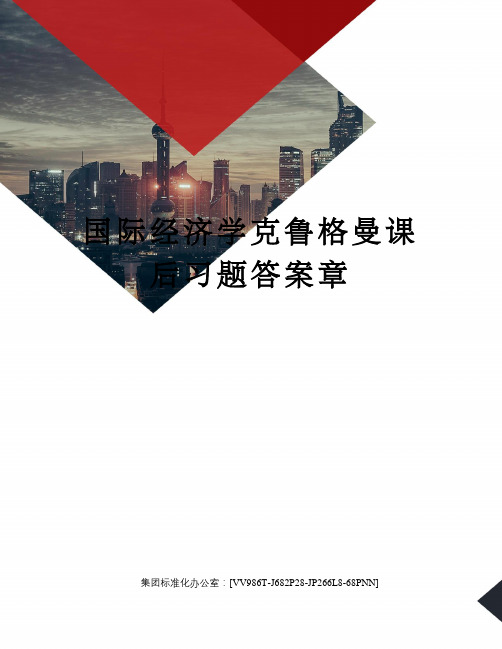
国际经济学克鲁格曼课后习题答案章集团标准化办公室:[VV986T-J682P28-JP266L8-68PNN]第一章练习与答案1.为什么说在决定生产和消费时,相对价格比绝对价格更重要?答案提示:当生产处于生产边界线上,资源则得到了充分利用,这时,要想增加某一产品的生产,必须降低另一产品的生产,也就是说,增加某一产品的生产是有机会机本(或社会成本)的。
生产可能性边界上任何一点都表示生产效率和充分就业得以实现,但究竟选择哪一点,则还要看两个商品的相对价格,即它们在市场上的交换比率。
相对价格等于机会成本时,生产点在生产可能性边界上的位置也就确定了。
所以,在决定生产和消费时,相对价格比绝对价格更重要。
2.仿效图1—6和图1—7,试推导出Y商品的国民供给曲线和国民需求曲线。
答案提示:3.在只有两种商品的情况下,当一个商品达到均衡时,另外一个商品是否也同时达到均衡?试解释原因。
答案提示:4.如果生产可能性边界是一条直线,试确定过剩供给(或需求)曲线。
答案提示:5.如果改用Y商品的过剩供给曲线(B国)和过剩需求曲线(A国)来确定国际均衡价格,那么所得出的结果与图1—13中的结果是否一致?6.答案提示:国际均衡价格将依旧处于贸易前两国相对价格的中间某点。
7.说明贸易条件变化如何影响国际贸易利益在两国间的分配。
答案提示:一国出口产品价格的相对上升意味着此国可以用较少的出口换得较多的进口产品,有利于此国贸易利益的获得,不过,出口价格上升将不利于出口数量的增加,有损于出口国的贸易利益;与此类似,出口商品价格的下降有利于出口商品数量的增加,但是这意味着此国用较多的出口换得较少的进口产品。
对于进口国来讲,贸易条件变化对国际贸易利益的影响是相反的。
8.如果国际贸易发生在一个大国和一个小国之间,那么贸易后,国际相对价格更接近于哪一个国家在封闭下的相对价格水平?答案提示:贸易后,国际相对价格将更接近于大国在封闭下的相对价格水平。
克鲁格曼《国际经济学》(国际金融部分)课后习题答案(英文版)第一章
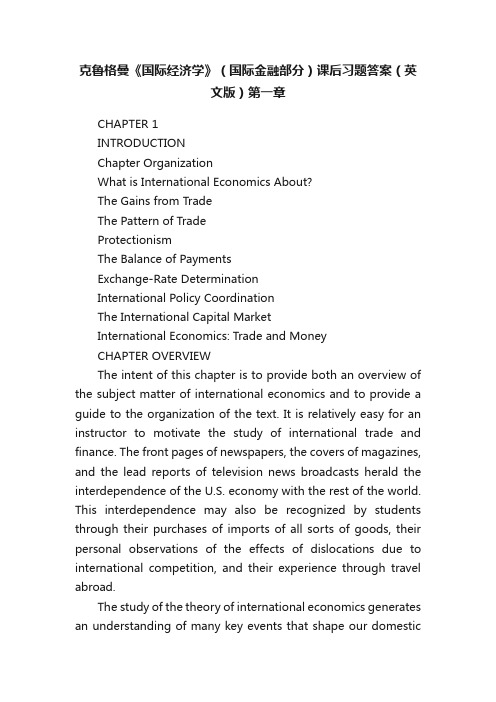
克鲁格曼《国际经济学》(国际金融部分)课后习题答案(英文版)第一章CHAPTER 1INTRODUCTIONChapter OrganizationWhat is International Economics About?The Gains from TradeThe Pattern of TradeProtectionismThe Balance of PaymentsExchange-Rate DeterminationInternational Policy CoordinationThe International Capital MarketInternational Economics: Trade and MoneyCHAPTER OVERVIEWThe intent of this chapter is to provide both an overview of the subject matter of international economics and to provide a guide to the organization of the text. It is relatively easy for an instructor to motivate the study of international trade and finance. The front pages of newspapers, the covers of magazines, and the lead reports of television news broadcasts herald the interdependence of the U.S. economy with the rest of the world. This interdependence may also be recognized by students through their purchases of imports of all sorts of goods, their personal observations of the effects of dislocations due to international competition, and their experience through travel abroad.The study of the theory of international economics generates an understanding of many key events that shape our domesticand international environment. In recent history, these events include the causes and consequences of the large current account deficits of the United States; the dramatic appreciation of the dollar during the first half of the 1980s followed by its rapid depreciation in the second half of the 1980s; the Latin American debt crisis of the 1980s and the Mexico crisis in late 1994; and the increased pressures for industry protection against foreign competition broadly voiced in the late 1980s and more vocally espoused in the first half of the 1990s. Most recently, the financial crisis that began in East Asia in 1997 andspread to many countries around the globe and the Economic and Monetary Union in Europe have highlighted the way in which various national economies are linked and how important it is for us to understand these connections. At the same time, protests at global economic meetings have highlighted opposition to globalization. The text material will enable students to understand the economic context in which such events occur.Chapter 1 of the text presents data demonstrating the growth in trade and increasing importance of international economics. This chapter also highlights and briefly discusses seven themes which arise throughout the book. These themes include: 1) the gains from trade;2) the pattern of trade; 3) protectionism; 4), the balance of payments; 5) exchange rate determination; 6) international policy coordination; and 7) the international capital market. Students will recognize that many of the central policy debates occurring today come under the rubric of one of these themes. Indeed, it is often a fruitful heuristic to use current events to illustrate the force of the key themes and arguments which are presentedthroughout the text.。
《国际经济学》课后习题参考答案
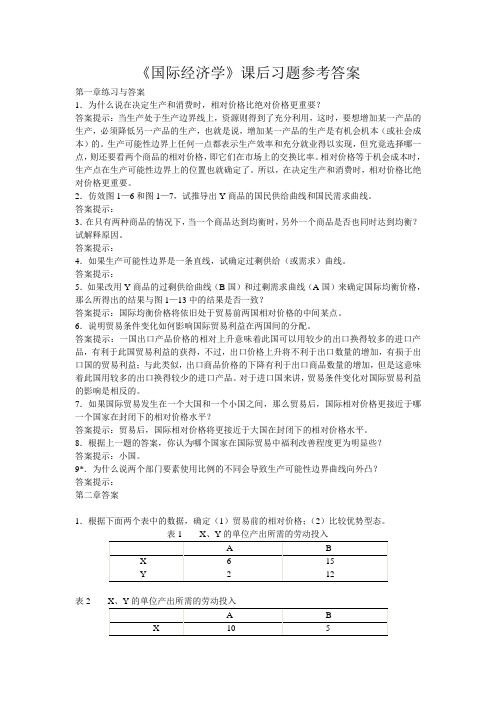
《国际经济学》课后习题参考答案第一章练习与答案1.为什么说在决定生产和消费时,相对价格比绝对价格更重要?答案提示:当生产处于生产边界线上,资源则得到了充分利用,这时,要想增加某一产品的生产,必须降低另一产品的生产,也就是说,增加某一产品的生产是有机会机本(或社会成本)的。
生产可能性边界上任何一点都表示生产效率和充分就业得以实现,但究竟选择哪一点,则还要看两个商品的相对价格,即它们在市场上的交换比率。
相对价格等于机会成本时,生产点在生产可能性边界上的位置也就确定了。
所以,在决定生产和消费时,相对价格比绝对价格更重要。
2.仿效图1—6和图1—7,试推导出Y商品的国民供给曲线和国民需求曲线。
答案提示:3.在只有两种商品的情况下,当一个商品达到均衡时,另外一个商品是否也同时达到均衡?试解释原因。
答案提示:4.如果生产可能性边界是一条直线,试确定过剩供给(或需求)曲线。
答案提示:5.如果改用Y商品的过剩供给曲线(B国)和过剩需求曲线(A国)来确定国际均衡价格,那么所得出的结果与图1—13中的结果是否一致?答案提示:国际均衡价格将依旧处于贸易前两国相对价格的中间某点。
6.说明贸易条件变化如何影响国际贸易利益在两国间的分配。
答案提示:一国出口产品价格的相对上升意味着此国可以用较少的出口换得较多的进口产品,有利于此国贸易利益的获得,不过,出口价格上升将不利于出口数量的增加,有损于出口国的贸易利益;与此类似,出口商品价格的下降有利于出口商品数量的增加,但是这意味着此国用较多的出口换得较少的进口产品。
对于进口国来讲,贸易条件变化对国际贸易利益的影响是相反的。
7.如果国际贸易发生在一个大国和一个小国之间,那么贸易后,国际相对价格更接近于哪一个国家在封闭下的相对价格水平?答案提示:贸易后,国际相对价格将更接近于大国在封闭下的相对价格水平。
8.根据上一题的答案,你认为哪个国家在国际贸易中福利改善程度更为明显些?答案提示:小国。
国际经济学的课后答案及选择

第一章绪论(一) 选择题1.国际经济学在研究资源配置时,是以(D.政府)作为基本的经济单位来划分的。
2.国际经济学研究的对象是(D 各国之间的经济活动和经济关系)3.从国际间经济资源流动的难易度看,(C人员)流动最容易(二)问答题1.试述国际经济学和国内经济学的关系。
答案提示:(1)联系:国际经济学与国内经济学研究的经济活动是相似的,面临的主要问题也是相似的;(2)最主要的区别是国际经济的民族国家性。
第二章古典的国际贸易理论(一)选择题本国生产A、B、C、D四种产品的单位劳动投入分别为1、2、4、15,外国生产这四种产品的单位劳动投入分别为12、18、24、30,根据李嘉图模型,本国在哪种产品上拥有最大比较优势?在哪种产品上拥有最大比较劣势?((c)A、D)答案:C(二)问答题1.亚当·斯密对国际贸易理论的主要贡献有哪些?答案提示:亚当·斯密的主要贡献是:(1)抨击了重商主义;(2)提出了绝对优势之一概念;(3)强调国际分工是使国民财富增加的最重要手段。
2.绝对优势理论和比较优势理论的区别是什么?答案提示:(1)绝对优势理论强调,国与国之间劳动生产率的绝对差异导致的技术水平的差异是产生国际贸易的主要原因;(2)比较优势理论强调,劳动生产率的相对差异导致的技术水平的差异是产生国际贸易的主要原因。
第二章问答题2.假设A、B两国的生产技术条件如下所示,那么两国还有进行贸易的动机吗?解释原因。
答案提示:从绝对优势来看,两国当中A国在两种产品中都有绝对优势;从比较优势来看,两国不存在相对技术差异。
所以,两国没有进行国际贸易的动机。
3.证明即使一国在某一商品上具有绝对优势,也未必具有比较优势。
答案提示:如果ax>bx,则称A国在X生产上具有绝对优势;如果ax/ay>bx/by,则称A国在X生产上具有比较优势。
当 ay=by或者ay<by的时候,由ax>bx可以推出ax/ay>bx/by,但是,当ay>by的时候,ax>bx不能保证。
国际经济学第五版第一章答案
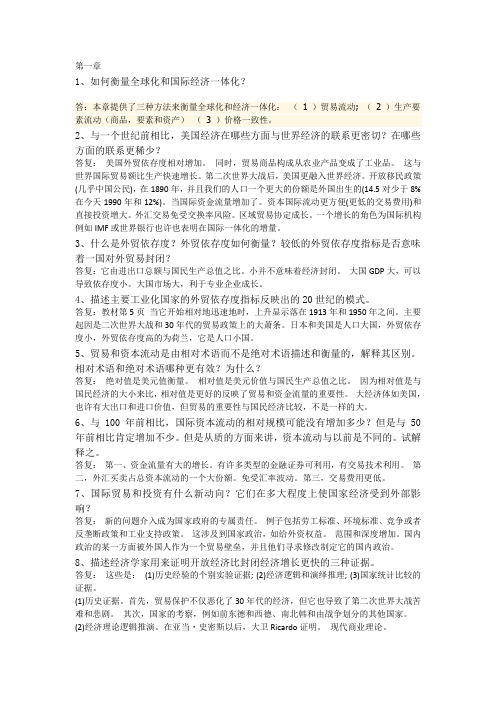
第一章1、如何衡量全球化和国际经济一体化?答:本章提供了三种方法来衡量全球化和经济一体化:( 1 )贸易流动; (2 )生产要素流动(商品,要素和资产)( 3 )价格一致性。
2、与一个世纪前相比,美国经济在哪些方面与世界经济的联系更密切?在哪些方面的联系更稀少?答复:美国外贸依存度相对增加。
同时,贸易商品构成从农业产品变成了工业品。
这与世界国际贸易额比生产快速增长。
第二次世界大战后,美国更融入世界经济。
开放移民政策(几乎中国公民),在1890年,并且我们的人口一个更大的份额是外国出生的(14.5对少于8%在今天1990年和12%)。
当国际资金流量增加了。
资本国际流动更方便(更低的交易费用)和直接投资增大。
外汇交易免受交换率风险。
区域贸易协定成长。
一个增长的角色为国际机构例如IMF或世界银行也许也表明在国际一体化的增量。
3、什么是外贸依存度?外贸依存度如何衡量?较低的外贸依存度指标是否意味着一国对外贸易封闭?答复:它由进出口总额与国民生产总值之比。
小并不意味着经济封闭。
大国GDP大,可以导致依存度小。
大国市场大,利于专业企业成长。
4、描述主要工业化国家的外贸依存度指标反映出的20世纪的模式。
答复:教材第5页当它开始相对地迅速地时,上升显示落在1913年和1950年之间。
主要起因是二次世界大战和30年代的贸易政策上的大萧条。
日本和美国是人口大国,外贸依存度小,外贸依存度高的为荷兰,它是人口小国。
5、贸易和资本流动是由相对术语而不是绝对术语描述和衡量的,解释其区别。
相对术语和绝对术语哪种更有效?为什么?答复:绝对值是美元值衡量。
相对值是美元价值与国民生产总值之比。
因为相对值是与国民经济的大小来比,相对值是更好的反映了贸易和资金流量的重要性。
大经济体如美国,也许有大出口和进口价值,但贸易的重要性与国民经济比较,不是一样的大。
6、与100年前相比,国际资本流动的相对规模可能没有增加多少?但是与50年前相比肯定增加不少。
《国际经济学(第四版)》课后复习与思考参考答案-第1章到第4章精选全文完整版
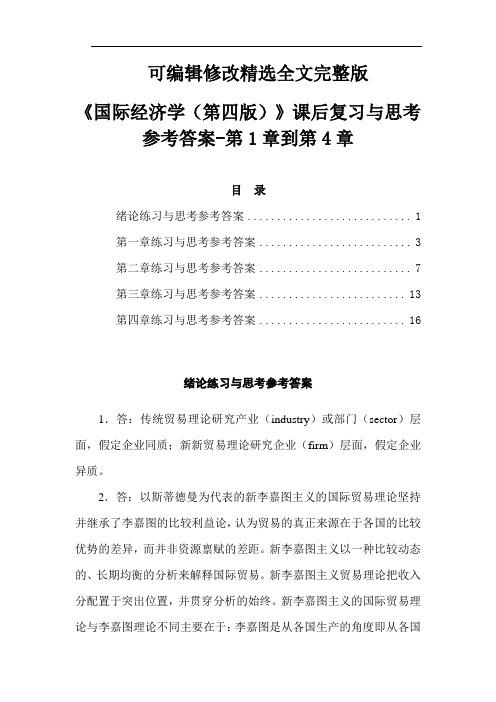
可编辑修改精选全文完整版《国际经济学(第四版)》课后复习与思考参考答案-第1章到第4章目录绪论练习与思考参考答案 (1)第一章练习与思考参考答案 (3)第二章练习与思考参考答案 (7)第三章练习与思考参考答案 (13)第四章练习与思考参考答案 (16)绪论练习与思考参考答案1.答:传统贸易理论研究产业(industry)或部门(sector)层面,假定企业同质;新新贸易理论研究企业(firm)层面,假定企业异质。
2.答:以斯蒂德曼为代表的新李嘉图主义的国际贸易理论坚持并继承了李嘉图的比较利益论,认为贸易的真正来源在于各国的比较优势的差异,而并非资源禀赋的差距。
新李嘉图主义以一种比较动态的、长期均衡的分析来解释国际贸易。
新李嘉图主义贸易理论把收入分配置于突出位置,并贯穿分析的始终。
新李嘉图主义的国际贸易理论与李嘉图理论不同主要在于:李嘉图是从各国生产的角度即从各国的生产特点不同和劳动效率的高低不同上来解释比较优势的差异;新李嘉图主义不仅从各国生产的角度来分析和比较各国的比较优势的差异,而且强调要从各国分配领域,从经济增长、经济发展的动态角度来分析和比较各国比较优势的不同。
3.答:北京师范大学李翀教授认为,马克思曾经有一个六册著作的写作计划,准备研究国内和国际经济问题,建立一个完整的经济理论体系。
然而遗憾的是,马克思没有能够完成他的研究工作。
将马克思经济学的基本理论和基本方法应用于国际经济问题的研究,构建马克思主义国际经济学理论体系,是一个很有意义的研究领城。
随着经济的全球化,国际经济体系已经成熟,建立马克思主义国际经济学的条件已经具备。
国际经济的本质是资本的跨国流动,因此,应该从商品资本、生产资本、货币资本的跨国流动三个方面来构建马克思主义国际经济学。
在商品资本的跨国流动方面,需要从国际价值、生产价格和垄断价格等基本范畴出发,来分析国际贸易的原因、流向和利益分配。
在生产资本的跨国流动方面,需要从生产资本本质的角度重新构建直接投资的原因、流向和利益分配。
国际经济学习题课后答案
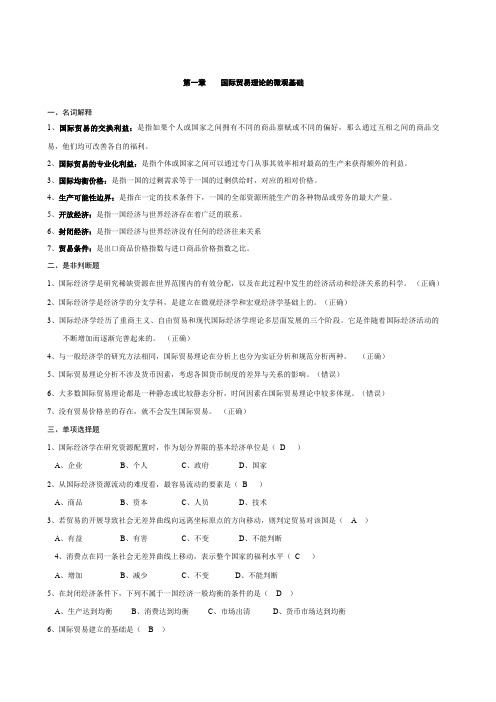
第一章国际贸易理论的微观基础一、名词解释1、国际贸易的交换利益:是指如果个人或国家之间拥有不同的商品禀赋或不同的偏好,那么通过互相之间的商品交易,他们均可改善各自的福利。
2、国际贸易的专业化利益:是指个体或国家之间可以通过专门从事其效率相对最高的生产来获得额外的利益。
3、国际均衡价格:是指一国的过剩需求等于一国的过剩供给时,对应的相对价格。
4、生产可能性边界:是指在一定的技术条件下,一国的全部资源所能生产的各种物品或劳务的最大产量。
5、开放经济:是指一国经济与世界经济存在着广泛的联系。
6、封闭经济:是指一国经济与世界经济没有任何的经济往来关系7、贸易条件:是出口商品价格指数与进口商品价格指数之比。
二、是非判断题1、国际经济学是研究稀缺资源在世界范围内的有效分配,以及在此过程中发生的经济活动和经济关系的科学。
(正确)2、国际经济学是经济学的分支学科,是建立在微观经济学和宏观经济学基础上的。
(正确)3、国际经济学经历了重商主义、自由贸易和现代国际经济学理论多层面发展的三个阶段。
它是伴随着国际经济活动的不断增加而逐渐完善起来的。
(正确)4、与一般经济学的研究方法相同,国际贸易理论在分析上也分为实证分析和规范分析两种。
(正确)5、国际贸易理论分析不涉及货币因素,考虑各国货币制度的差异与关系的影响。
(错误)6、大多数国际贸易理论都是一种静态或比较静态分析,时间因素在国际贸易理论中较多体现。
(错误)7、没有贸易价格差的存在,就不会发生国际贸易。
(正确)三、单项选择题1、国际经济学在研究资源配置时,作为划分界限的基本经济单位是(D )A、企业B、个人C、政府D、国家2、从国际经济资源流动的难度看,最容易流动的要素是(B )A、商品B、资本C、人员D、技术3、若贸易的开展导致社会无差异曲线向远离坐标原点的方向移动,则判定贸易对该国是( A )A、有益B、有害C、不变D、不能判断4、消费点在同一条社会无差异曲线上移动,表示整个国家的福利水平(C )A、增加B、减少C、不变D、不能判断5、在封闭经济条件下,下列不属于一国经济一般均衡的条件的是( D )A、生产达到均衡B、消费达到均衡C、市场出清D、货币市场达到均衡6、国际贸易建立的基础是( B )A、绝对价格B、相对价格C、不变价格D、以上三种都不是7、在封闭经济条件下,A国X商品的相对价格低于B国X商品的相对价格,我们称A国在X商品上具有( B )A、绝对优势B、比较优势C、没有优势D、以上三种都不是8、一国从国际贸易中所获利益的多寡取决于( D )A、市场占有率B、技术优势C、竞争优势D、贸易条件四、简述题:1、试用图形分析国际贸易的交换利益和专业化利益。
国际经济学第三版课后练习题含答案
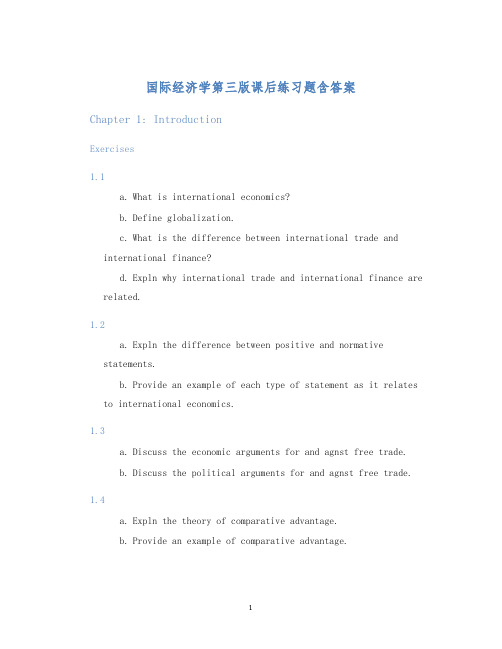
国际经济学第三版课后练习题含答案Chapter 1: IntroductionExercises1.1a.What is international economics?b.Define globalization.c.What is the difference between international trade andinternational finance?d.Expln why international trade and international finance arerelated.1.2a.Expln the difference between positive and normativestatements.b.Provide an example of each type of statement as it relatesto international economics.1.3a.Discuss the economic arguments for and agnst free trade.b.Discuss the political arguments for and agnst free trade.1.4a.Expln the theory of comparative advantage.b.Provide an example of comparative advantage.1.5a.Discuss the gns and losses from trade.b.Provide an example of the gns from trade.Answers1.1a.International economics is the study of how countriesinteract economically with each other and the consequences ofthose interactions.b.Globalization is the integration of economies and societiesacross the world through the exchange of goods, services, capital and people.c.International trade is the exchange of goods and servicesbetween countries. International finance refers to the movement of financial capital across borders, including foreign directinvestment, portfolio investment and international borrowing and lending.d.International trade and finance are related because tradenecessarily involves exchange of currencies, which in turn affects the demand and supply of currencies in international markets.1.2a.Positive statements are factual statements that can betested and verified or rejected based on evidence. Normativestatements are statements that express judgments or opinions about what ought to be.b.An example of a positive statement in international economics is。
克鲁格曼《国际经济学》(第8版)课后习题详解
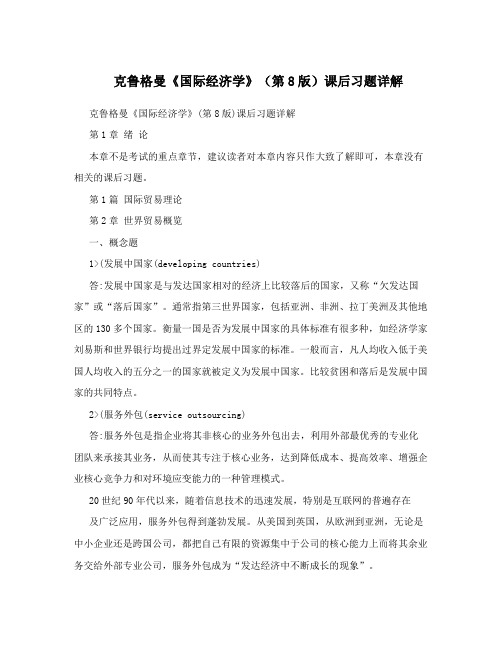
克鲁格曼《国际经济学》(第8版)课后习题详解克鲁格曼《国际经济学》(第8版)课后习题详解第1章绪论本章不是考试的重点章节,建议读者对本章内容只作大致了解即可,本章没有相关的课后习题。
第1篇国际贸易理论第2章世界贸易概览一、概念题1>(发展中国家(developing countries)答:发展中国家是与发达国家相对的经济上比较落后的国家,又称“欠发达国家”或“落后国家”。
通常指第三世界国家,包括亚洲、非洲、拉丁美洲及其他地区的130多个国家。
衡量一国是否为发展中国家的具体标准有很多种,如经济学家刘易斯和世界银行均提出过界定发展中国家的标准。
一般而言,凡人均收入低于美国人均收入的五分之一的国家就被定义为发展中国家。
比较贫困和落后是发展中国家的共同特点。
2>(服务外包(service outsourcing)答:服务外包是指企业将其非核心的业务外包出去,利用外部最优秀的专业化团队来承接其业务,从而使其专注于核心业务,达到降低成本、提高效率、增强企业核心竞争力和对环境应变能力的一种管理模式。
20世纪90年代以来,随着信息技术的迅速发展,特别是互联网的普遍存在及广泛应用,服务外包得到蓬勃发展。
从美国到英国,从欧洲到亚洲,无论是中小企业还是跨国公司,都把自己有限的资源集中于公司的核心能力上而将其余业务交给外部专业公司,服务外包成为“发达经济中不断成长的现象”。
3>(引力模型(gravity model)答:丁伯根和波伊赫能的引力模型基本表达式为:其中,是国与国的贸易额,为常量,是国的国内生产总值,是国的国内生产总值,是两国的距离。
、、三个参数是用来拟合实际的经济数据。
引力模型方程式表明:其他条件不变的情况下,两国间的贸易规模与两国的GDP成正比,与两国间的距离成反比。
把整个世界贸易看成整体,可利用引力模型来预测任意两国之间的贸易规模。
另外,引力模型也可以用来明确国际贸易中的异常现象。
4>(第三世界(third world)答:第三世界这个名词原本是指法国大革命中的Third Estate(第三阶级)。
克鲁格曼《国际经济学》(第8版)课后习题详解

克鲁格曼《国际经济学》(第8版)课后习题详解克鲁格曼《国际经济学》(第8版)课后习题详解第1章绪论本章不是考试的重点章节,建议读者对本章内容只作大致了解即可,本章没有相关的课后习题。
第1篇国际贸易理论第2章世界贸易概览一、概念题1>(发展中国家(developing countries)答:发展中国家是与发达国家相对的经济上比较落后的国家,又称“欠发达国家”或“落后国家”。
通常指第三世界国家,包括亚洲、非洲、拉丁美洲及其他地区的130多个国家。
衡量一国是否为发展中国家的具体标准有很多种,如经济学家刘易斯和世界银行均提出过界定发展中国家的标准。
一般而言,凡人均收入低于美国人均收入的五分之一的国家就被定义为发展中国家。
比较贫困和落后是发展中国家的共同特点。
2>(服务外包(service outsourcing)答:服务外包是指企业将其非核心的业务外包出去,利用外部最优秀的专业化团队来承接其业务,从而使其专注于核心业务,达到降低成本、提高效率、增强企业核心竞争力和对环境应变能力的一种管理模式。
20世纪90年代以来,随着信息技术的迅速发展,特别是互联网的普遍存在及广泛应用,服务外包得到蓬勃发展。
从美国到英国,从欧洲到亚洲,无论是中小企业还是跨国公司,都把自己有限的资源集中于公司的核心能力上而将其余业务交给外部专业公司,服务外包成为“发达经济中不断成长的现象”。
3>(引力模型(gravity model)答:丁伯根和波伊赫能的引力模型基本表达式为:其中,是国与国的贸易额,为常量,是国的国内生产总值,是国的国内生产总值,是两国的距离。
、、三个参数是用来拟合实际的经济数据。
引力模型方程式表明:其他条件不变的情况下,两国间的贸易规模与两国的GDP成正比,与两国间的距离成反比。
把整个世界贸易看成整体,可利用引力模型来预测任意两国之间的贸易规模。
另外,引力模型也可以用来明确国际贸易中的异常现象。
4>(第三世界(third world)答:第三世界这个名词原本是指法国大革命中的Third Estate(第三阶级)。
国际经济学的课后答案及选择
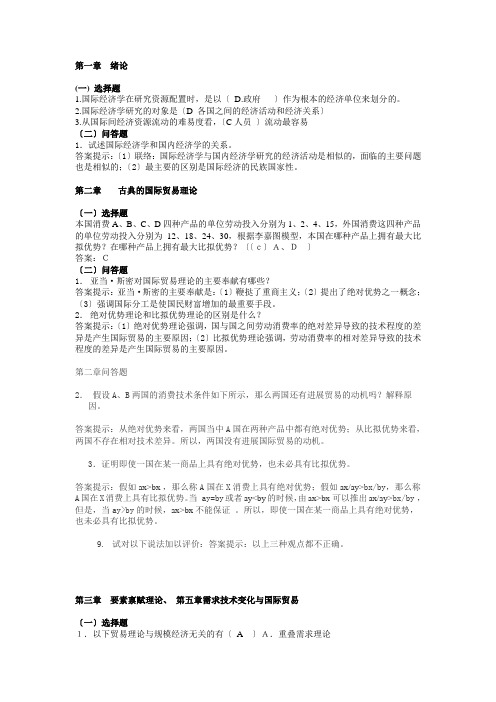
第一章绪论(一) 选择题1.国际经济学在研究资源配置时,是以〔D.政府〕作为根本的经济单位来划分的。
2.国际经济学研究的对象是〔D 各国之间的经济活动和经济关系〕3.从国际间经济资源流动的难易度看,〔C人员〕流动最容易〔二〕问答题1.试述国际经济学和国内经济学的关系。
答案提示:〔1〕联络:国际经济学与国内经济学研究的经济活动是相似的,面临的主要问题也是相似的;〔2〕最主要的区别是国际经济的民族国家性。
第二章古典的国际贸易理论〔一〕选择题本国消费A、B、C、D四种产品的单位劳动投入分别为1、2、4、15,外国消费这四种产品的单位劳动投入分别为12、18、24、30,根据李嘉图模型,本国在哪种产品上拥有最大比拟优势?在哪种产品上拥有最大比拟优势?〔〔c〕A、D〕答案:C〔二〕问答题1.亚当·斯密对国际贸易理论的主要奉献有哪些?答案提示:亚当·斯密的主要奉献是:〔1〕鞭挞了重商主义;〔2〕提出了绝对优势之一概念;〔3〕强调国际分工是使国民财富增加的最重要手段。
2.绝对优势理论和比拟优势理论的区别是什么?答案提示:〔1〕绝对优势理论强调,国与国之间劳动消费率的绝对差异导致的技术程度的差异是产生国际贸易的主要原因;〔2〕比拟优势理论强调,劳动消费率的相对差异导致的技术程度的差异是产生国际贸易的主要原因。
第二章问答题2.假设A、B两国的消费技术条件如下所示,那么两国还有进展贸易的动机吗?解释原因。
答案提示:从绝对优势来看,两国当中A国在两种产品中都有绝对优势;从比拟优势来看,两国不存在相对技术差异。
所以,两国没有进展国际贸易的动机。
3.证明即使一国在某一商品上具有绝对优势,也未必具有比拟优势。
答案提示:假如ax>bx,那么称A国在X消费上具有绝对优势;假如ax/ay>bx/by,那么称A国在X消费上具有比拟优势。
当 ay=by或者ay<by的时候,由ax>bx可以推出ax/ay>bx/by,但是,当ay>by的时候,ax>bx不能保证。
克鲁格曼《国际经济学》(第8版)课后习题详解
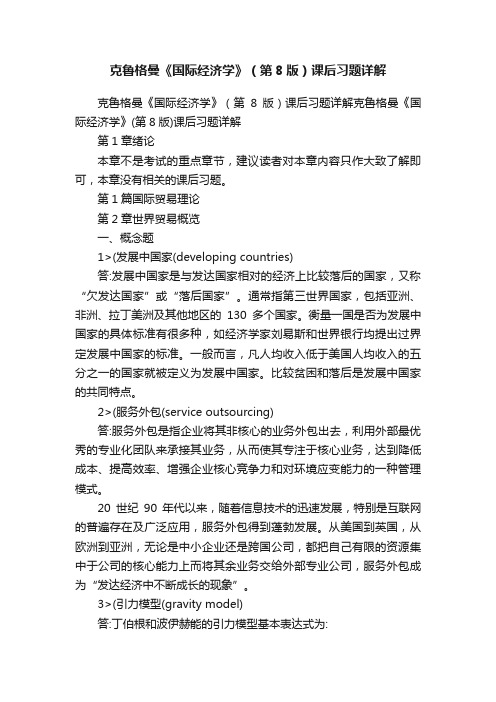
克鲁格曼《国际经济学》(第8版)课后习题详解克鲁格曼《国际经济学》(第8版)课后习题详解克鲁格曼《国际经济学》(第8版)课后习题详解第1章绪论本章不是考试的重点章节,建议读者对本章内容只作大致了解即可,本章没有相关的课后习题。
第1篇国际贸易理论第2章世界贸易概览一、概念题1>(发展中国家(developing countries)答:发展中国家是与发达国家相对的经济上比较落后的国家,又称“欠发达国家”或“落后国家”。
通常指第三世界国家,包括亚洲、非洲、拉丁美洲及其他地区的130多个国家。
衡量一国是否为发展中国家的具体标准有很多种,如经济学家刘易斯和世界银行均提出过界定发展中国家的标准。
一般而言,凡人均收入低于美国人均收入的五分之一的国家就被定义为发展中国家。
比较贫困和落后是发展中国家的共同特点。
2>(服务外包(service outsourcing)答:服务外包是指企业将其非核心的业务外包出去,利用外部最优秀的专业化团队来承接其业务,从而使其专注于核心业务,达到降低成本、提高效率、增强企业核心竞争力和对环境应变能力的一种管理模式。
20世纪90年代以来,随着信息技术的迅速发展,特别是互联网的普遍存在及广泛应用,服务外包得到蓬勃发展。
从美国到英国,从欧洲到亚洲,无论是中小企业还是跨国公司,都把自己有限的资源集中于公司的核心能力上而将其余业务交给外部专业公司,服务外包成为“发达经济中不断成长的现象”。
3>(引力模型(gravity model)答:丁伯根和波伊赫能的引力模型基本表达式为:其中,是国与国的贸易额,为常量,是国的国内生产总值,是国的国内生产总值,是两国的距离。
、、三个参数是用来拟合实际的经济数据。
引力模型方程式表明:其他条件不变的情况下,两国间的贸易规模与两国的GDP成正比,与两国间的距离成反比。
把整个世界贸易看成整体,可利用引力模型来预测任意两国之间的贸易规模。
另外,引力模型也可以用来明确国际贸易中的异常现象。
中国大学mooc《国际经济学(首都经济贸易大学) 》满分章节测试答案
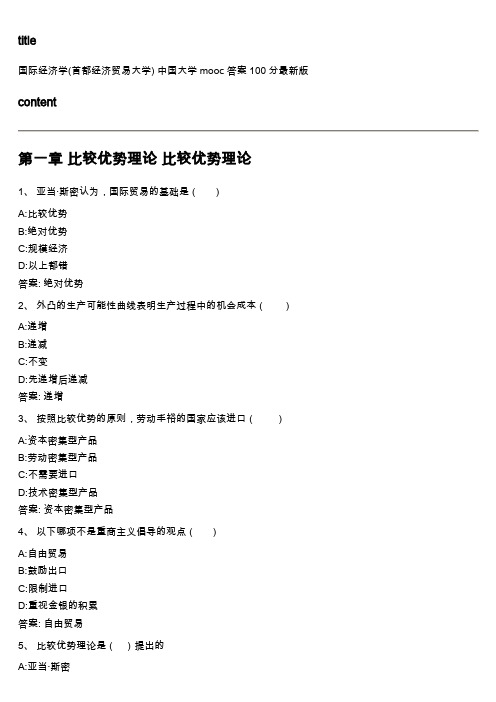
title国际经济学(首都经济贸易大学) 中国大学mooc答案100分最新版content第一章比较优势理论比较优势理论1、亚当·斯密认为,国际贸易的基础是()A:比较优势B:绝对优势C:规模经济D:以上都错答案: 绝对优势2、外凸的生产可能性曲线表明生产过程中的机会成本()A:递增B:递减C:不变D:先递增后递减答案: 递增3、按照比较优势的原则,劳动丰裕的国家应该进口()A:资本密集型产品B:劳动密集型产品C:不需要进口D:技术密集型产品答案: 资本密集型产品4、以下哪项不是重商主义倡导的观点()A:自由贸易B:鼓励出口C:限制进口D:重视金银的积累答案: 自由贸易5、比较优势理论是()提出的A:亚当·斯密B:大卫·李嘉图C:凯恩斯D:克鲁格曼答案: 大卫·李嘉图6、如果国家A每1单位劳动时间可以生产3单位X或者3单位Y,国家B每1单位劳动时间可以生产1单位X或者3单位Y,那么()A:国家A在生产X上具有比较劣势B:国家B在生产Y上具有比较劣势C:国家A在生产X上具有比较优势D:国家A在任何产品生产上都不具有比较优势答案: 国家A在生产X上具有比较优势7、李嘉图解释比较优势理论的基础是()A:劳动价值论B:机会成本理论C:规模报酬递减D:以上都正确答案: 劳动价值论8、两个国家相对产品价格的差异可能是基于()A:要素禀赋的差异B:技术的差异C:消费者偏好的差异D:以上都正确答案: 以上都正确9、假定机会成本不变,大国和小国进行贸易()A:大国可能获得全部贸易利益B:小国可能获得全部贸易利益C:大国和小国平分贸易利益D:以上都不正确答案: 小国可能获得全部贸易利益10、如果国家A每1单位劳动时间可以生产3单位X或者3单位Y,国家B每1单位劳动时间可以生产1单位X或者3单位Y,如果国家A拿3单位X交换3单位Y,那么()A:国家A获利2单位XB:国家B获利6单位YC:国家A获利3单位YD:国家B获利3单位Y答案: 国家B获利6单位Y11、李嘉图解释比较理论的基础是()A:劳动价值论B:机会成本理论C:规模报酬递减D:以上都正确答案: 劳动价值论12、假定机会成本不变,大国和小国进行贸易:()A:大国可能获得全部贸易利益B:小国可能获得全部贸易利益C:大国和小国平分贸易利益D:以上都不正确答案: 以上都不正确作业第一章比较优势理论比较优势理论1、请简要阐述重商主义的主要观点。
国际经济学高等教育出版社课后答案李坤望

2、经济一体化由低到高可分为五种形式:自由贸易区、关税同 盟、共同市场、经济联盟和完全的经济一体、。
3、关税同盟对国际贸易和区域内外的国家及世界福利都会产生影 响。其对贸易的影响可区分为贸易创造 和贸易转移两种效应。
第二章:
1、斯密的绝对优势论认为国际贸易的基础是各国之间劳动生产率
的绝对 差别;李嘉图的比较优势论认为国际贸易的基础是各国之间劳
动生产率的 相对 差别。
2、哈伯勒首先用 机会成本 概念来阐明比较优势论。
3、重商主义者提倡的国家经济政策有:限制进口和鼓励出口,采
取奖金、退税、协定和殖民地贸易等措施鼓励出口。
第七章:
1、各国对对外贸易的干预手段可分为关税和非关税壁垒两大类。 2、关税是一种价格控制手段,有多种形式,如进口关税、进口附 加税、过境税、出口税等。 3、进口关税的征收对一国的生产者有利,但不利于消费者。 4、在小国情形下,进口关税会导致社会福利损失;在大国情形 下,关税的净福利效果不确定 。 5、进口配额是一种通过对进口数量的限制达到保护本国生产的非 关税措施,它所起到的贸易限制作用往往比关税要大,不易渗透。进口 配额的影响效应与关税大致相同。 6、进口配额常常与进口许可证结合起来使用,因此在操作过程中 透明度较差,容易引发“寻租”等浪费资源的行为。 7、出口补贴是政府对出口采取补贴的方法,以提高出口企业的竞 争力,扩大本国出口。 8、倾销是一种企业低价竞争行为,有利于进口国的消费者,但对 进口国的生产者可能会带来严重后果。所以,进口国的生产者往往会要 求政府采取反倾销税等措施,抵消来自他国倾销的影响。 9、倾销可分为两种类型,一种是持续性倾销,另一种是掠夺式倾
国际经济学课后习题答案
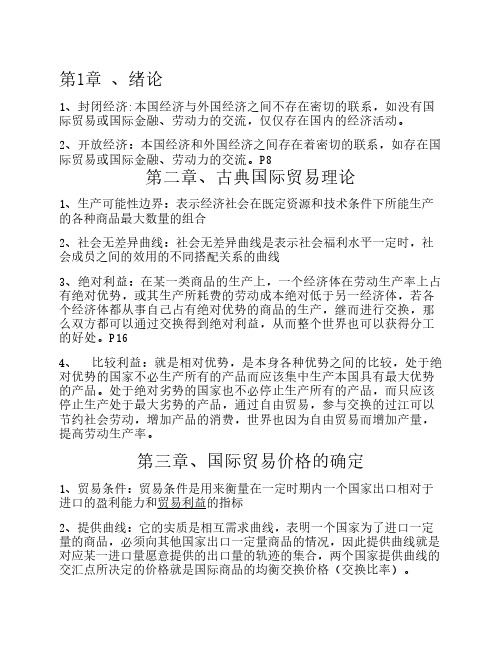
4、马歇尔—勒纳条件:本国出口的价格需求弹性与本国进口的价格需 求弹性之和的绝对值必须大于1,即商品的进出口变化对于价格调整的 反应要大。
3、自由贸易区:是经济一体化组织较低层次的形式,即一体化密切程 度较差的一种形式。成员国间取消关税壁垒,对其他国家各自仍然保持 独立的关税。
4、 关税同盟:经济一体化在发展过程中的一个阶段,它除了在成员国 间取消关税壁垒,而且采取共同的对外关税,关税收入按照既定的比例 进行分配。
7、国际贸易产品生命周期学说:是将周期理论与国际贸易结合起来, 认定国际贸易的发生是由于不同国家之间生产技术方面存在着差距,
技术差距的产生于缩小会改变国际贸易中的比较利益,从而使国际贸 易中所谓比较利益从静态发展成为动态即比较利益从一个或一类国家 转移(传导)到另一个或一类国家,一类产品的生产的优势因而从一 个国家转移到另外的国家,国际贸易的价格也因而发生变化。
第5章 、国际贸易的现代与当代理论(II)
1、 产业内贸易理论:是国际经济学界产生了一种新理论,主要针对国 际贸易大多发生在发达国家之间,并既进口又出口同类产品的现象。产 业内贸易理论,有其理论的假设前提、相应的理论解释。对产品的同质 性、异质性与产业内贸易现象进行解释,并提出了产业内贸易指数的计 算方式。
2、社会无差异曲线:社会无差异曲线是表示社会福利水平一定时,社 会成员之间的效用的不同搭配关系的曲线
3、绝对利益:在某一类商品的生产上,一个经济体在劳动生产率上占 有绝对优势,或其生产所耗费的劳动成本绝对低于另一经济体,若各 个经济体都从事自己占有绝对优势的商品的生产,继而进行交换,那 么双方都可以通过交换得到绝对利益,从而整个世界也可以获得分工 的好处。P16
国际经济学部分答案(详细解答过程)

国际经济学习题答案第一章1.为什么说在决定生产和消费时,相对价格比绝对价格更重要?答案提示:当生产处于生产边界线上,资源则得到了充分利用,这时,要想增加某一产品的生产,必须降低另一产品的生产,也就是说,增加某一产品的生产是有机会机本(或社会成本)的。
生产可能性边界上任何一点都表示生产效率和充分就业得以实现,但究竟选择哪一点,则还要看两个商品的相对价格,即它们在市场上的交换比率。
相对价格等于机会成本时,生产点在生产可能性边界上的位置也就确定了。
所以,在决定生产和消费时,相对价格比绝对价格更重要2.仿效图1—6和图1—7,试推导出Y商品的国民供给曲线和国民需求曲线。
答:参见教材第一章第二节内容,将图1-6a中,以横坐标表示y商品的供给,以纵坐标表示x商品供给,得出相应生产可能性边界线,然后将图1-6b中,以横坐标表示y商品供给,以纵坐标表示y的相对价格,通过类似推导可得出国民供给曲线,国民需求曲线作类似推导可得。
3.在只有两种商品的情况下,当一个商品达到均衡时,另外一个商品是否也同时达到均衡?答:两种商品同时达到均衡。
一种商品均衡时,由其相对价格,机会成本,需求可知另一种商品得相对价格,机会成本和需求。
4.如果生产可能性边界是一条直线,试确定过剩供给(或需求)曲线。
答案提示:略,参见书上5.如果改用Y商品的过剩供给曲线(B国)和过剩需求曲线(A国)来确定国际均衡价格,那么所得出的结果与图1—13中的结果是否一致?答案提示:国际均衡价格将依旧处于贸易前两国相对价格的中间某点。
6.说明贸易条件变化如何影响国际贸易利益在两国间的分配。
答案提示:一国出口产品价格的相对上升意味着此国可以用较少的出口换得较多的进口产品,有利于此国贸易利益的获得,不过,出口价格上升将不利于出口数量的增加,有损于出口国的贸易利益;与此类似,出口商品价格的下降有利于出口商品数量的增加,但是这意味着此国用较多的出口换得较少的进口产品。
ch04国际经济学课后答案与习题萨尔瓦多
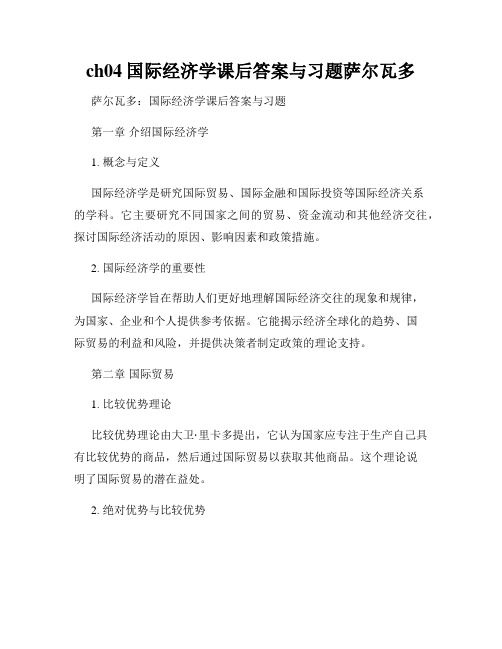
ch04国际经济学课后答案与习题萨尔瓦多萨尔瓦多:国际经济学课后答案与习题第一章介绍国际经济学1. 概念与定义国际经济学是研究国际贸易、国际金融和国际投资等国际经济关系的学科。
它主要研究不同国家之间的贸易、资金流动和其他经济交往,探讨国际经济活动的原因、影响因素和政策措施。
2. 国际经济学的重要性国际经济学旨在帮助人们更好地理解国际经济交往的现象和规律,为国家、企业和个人提供参考依据。
它能揭示经济全球化的趋势、国际贸易的利益和风险,并提供决策者制定政策的理论支持。
第二章国际贸易1. 比较优势理论比较优势理论由大卫·里卡多提出,它认为国家应专注于生产自己具有比较优势的商品,然后通过国际贸易以获取其他商品。
这个理论说明了国际贸易的潜在益处。
2. 绝对优势与比较优势绝对优势是指某个国家在生产某种商品上的效率高于其他国家,而比较优势则是指某个国家在生产某种商品上的机会成本低于其他国家。
比较优势是基于机会成本而产生的。
第三章国际金融1. 汇率与汇率制度汇率是一种货币兑换为另一种货币的比率。
汇率制度是指国家对其货币与其他货币之间的兑换比率进行管理和调整的体系。
汇率制度根据不同的货币政策和国家经济状况而有所不同,如固定汇率制和浮动汇率制等。
2. 随机汇率与管理型汇率制度随机汇率是由市场力量决定的汇率,在市场上自由浮动。
管理型汇率制度是由政府或央行干预市场来控制或影响汇率的变动。
第四章国际投资1. 直接投资与证券投资直接投资是指投资者通过购买或建立企业、工厂或设施等方式,在境外进行经济活动。
证券投资则是指投资者通过购买股票、债券或其他金融资产来获得收益。
2. 外国企业与政府投资外国企业可以通过直接投资的方式,在其他国家建立子公司或扩大在其它国家的经营规模。
政府投资则是指政府通过直接投资的方式,参与国际投资活动,以增加国家的影响力和经济实力。
结语国际经济学是一门重要的学科,它帮助我们理解国际经济交往的规律,为决策者制定政策提供理论支持。
- 1、下载文档前请自行甄别文档内容的完整性,平台不提供额外的编辑、内容补充、找答案等附加服务。
- 2、"仅部分预览"的文档,不可在线预览部分如存在完整性等问题,可反馈申请退款(可完整预览的文档不适用该条件!)。
- 3、如文档侵犯您的权益,请联系客服反馈,我们会尽快为您处理(人工客服工作时间:9:00-18:30)。
PART I INSTRUCTOR’S MANUALCHAPTER 1THE INTERNATIONAL ECONOMYCHAPTER OVERVIEWThis chapter introduces students to the international economy. The first part of the chapter emphasizes the high degree of economic interdependence that charac terizes today’s economies. Economic interdependence includes international trade and international finance.The chapter also focuses on the United States as an open economy. Data are provided that show U.S. exports as a percent of gross domestic product and the value of U.S. trade with its major trading partners. The chapter notes that many U.S. firms source a portion of the production of their goods in foreign countries.The chapter concludes by discussing the nature of international competitiveness--for firms, industries, and nations. It is noted that exposure to global competition tends to improve the efficiency of firms. Finally, the chapter introduces the potential effects that international trade has on workers.After completing the chapter, students should be able to:∙Define economic interdependence.∙Discuss the importance of international trade for the U.S. economy.∙Examine the factors that make a company American.∙Discuss the nature of competitiveness and how it applies to firms, industries, and nations.∙Identify the advantages and disadvantages of international trade for workers.BRIEF ANSWERS TO STUDY QUESTIONS1. Interdependence among today's economies reflects the historical evolution of the world's economic andpolitical order. Since World War II, Europe and Japan have reindustrialized. What is more, the formation of the European Community and the Organization of Petroleum Exporting Countries, as well as the rise of multinational corporations, has contributed to closer economic and political linkages.2. Proponents of an open trading system maintain that free trade leads to lower prices, the development ofmore efficient production methods, and a greater range of consumption choices. Free trade permitsresources to move from their lowest productivity to their highest productivity. Critics of an open trading system maintain that import competition may displace domestic firms and workers. It is also argued that during periods of national emergency, it is in the best interests of a nation to protect strategic industries.3. For the United States, growing economic interdependence has resulted in exports and imports increasingas a share of national output. Profits of domestic firms and wages of domestic workers are increasingly being affected by foreign competition. Political and economic events play important roles for theoperation of some sectors of the American economy, such as energy and agriculture.2Chapter 1: The International Economy 34. The volume of international trade is governed by factors including the level of domestic economic activity(e.g., prosperity versus recession) and restrictions imposed by countries on their imports.5. The chapter describes three fallacies of international trade:a. Trade is a zero sum activityb. Imports reduce employment and act as a drag on the economyc. Tariffs and quotas will save jobs and promote a higher level of employment6. International competitiveness refers to the extent to which the goods of a firm or industry can compete inthe marketplace; this competitiveness depends on the relative prices and qualities of products. No nation can be competitive in, and thus be a net exporter of everything. Because a nation’s stock of resources is limited, the ideal is for these resources to be used in their most productive manner. Nations will benefit from specialization and trade by exporting products having a comparative advantage.7. Researchers at the McKinsey Global Institute have found that global competitiveness is a bit like sports.You get better by playing against folks who are better than you. This means companies are exposed to intense global competition tend to be more productive than those who aren’t.8.International trade benefits most workers, especially those in exporting industries. In addition to providingthem jobs and income, it allows them to shop for consumption goods that are cheapest and of the highest quality. However, workers in import-competing industries often feel threatened from competition ofcheap foreign labor.9.Among the challenges confronting the international trading system are maintaining fair standards for laborand promoting environmental quality.10.The threat of international terrorism tends to slow the degree of globalization and also make it becomecostlier. With terrorism, companies must pay more to insure and provide security for overseas staff and property. Heightened border inspections could slow shipments of cargo, forcing companies to stock more inventory. Tighter immigration policies could reduce the liberal inflows of skilled and blue-collarlaborers that permitted companies to expand while keeping wages in check. Moreover, a greaterpreoccupation with political risk has companies greatly narrowing their horizons when making newinvestments.。
